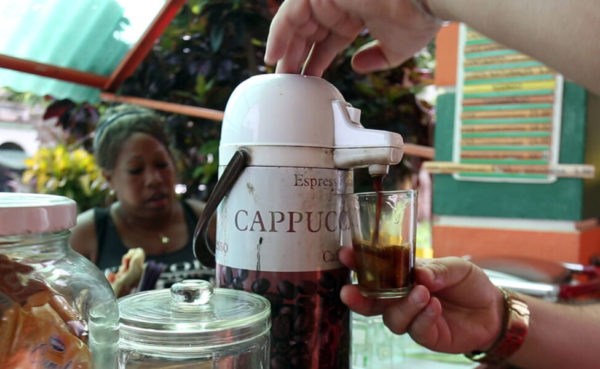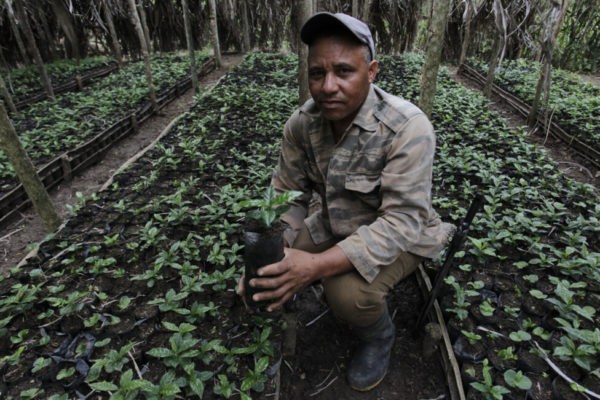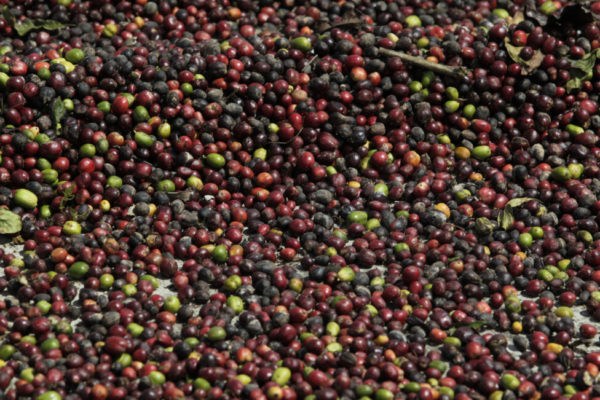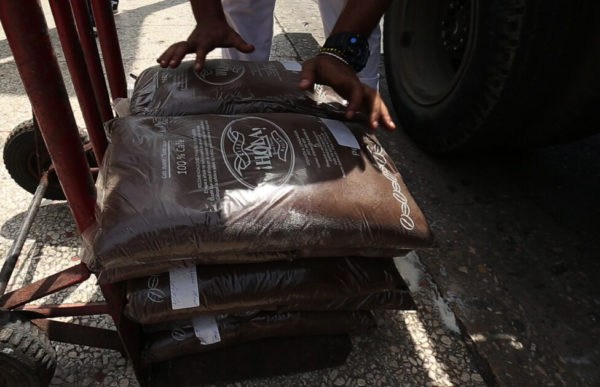Cubans Wait to Drink Their Daily Coffee Again

By Luis Brizuela (IPS Cuba)
HAVANA TIMES – While government plans to increase coffee production bear fruit, Mireya Barrios admits that she does everything she can to try and enjoy a cup of coffee every day, amidst high prices and shortages of a product that is now distant to the national palate.
“My body falls apart if I don’t drink it, I have a headache all day. Drinking coffee is almost as important as eating for me,” Barrios says. She receives coffee from family members who “bring it from the East, where the best Cuban coffee is grown”, which is roasted and mixed with chickpeas to bulk it up.
After putting some of it aside for her household’s consumption, she prepares another batch of coffee that she sells every morning in one of Centro Havana’s hundreds of doorways.
“This buchito (swig) of hot coffee is sometimes the breakfast of those who go to work and don’t make it at home because they’re in a rush, or because they don’t have any coffee since it is not only hard to find but also very expensive,” Bermudez points out in an interview with IPS.
Coffee forms part of the basic rations on the island. Every month, the government sells a packet of 115 grams (1/4 pound) mixed with 50% of chickpeas, per person and at a subsidized price.
In recent months, there have been delays in distribution because raw materials have come in late, including paper to package it, as a result of the Caribbean island’s financial problems ami a more severe economic crisis, which dates back three decades.
“We collected half a ton of good quality coffee, in 2021. We hoped that Doña Esperanza would slowly become a coffee farm in the plains with higher productions levels of quality coffee for export and national consumption, which is desperately needed”: Esperanza Gonzalez.
Residents living in some of Cuba’s 168 municipalities were consulted by IPS and admitted that the coffee ration “is barely enough for 7-10 days, when they use it sparingly.”
If they have the money, people normally look to the illicit market to buy more. There, the same 115 grams packet – which is taken from state warehouses or establishments a lot of the time in the first place – is sold for the equivalent of 0.50 USD.
Cuban and foreign brands of pure coffee are almost only sold in US dollar priced stores, which are inaccessible to many families who receive their wages in the devalued Cuban peso.
For example, a kilo of the national brand Cubita costs approximately 15 USD in a country where the average monthly wage is approximately 32 USD, according to the official 120 peso to 1 USD rate.

Boosting coffee production in the plains
Coffee reached Cuba in 1748 and had a strong boost after the Haitian Revolution (1791-1804), with the immigration of French-Haitian colonists who settled in the mountainous areas in the East of the island where they set up coffee plantations. Some of the ruins were declared World Heritage Sites by UNESCO in 2000.
During part of the 19th century, Cuba was Europe’s main exporter of coffee, sending 29,500 tons in 1833, for example.
Statistics indicate that the highest record was the 1961-1962 harvest, with 60,300 tons. However, production declined afterwards, and today, harvests aren’t exceeding 10,000 tons per year.
With a national demand of 24,000 tons per year, the important exporter of yesteryear now needs to import coffee from other countries, but in amounts that don’t satisfy the demand.
According to Elexis Legra, director of coffee and cocoa at the Agroforestry Group, which belongs to the Ministry of Agriculture, Cuba is exporting the Arabica variety – the best quality coffee – that coffee farmers produce in mountainous areas.
The idea is to begin to export small amounts of the Robusta variety, which is the most sought after on the international market.
The target for 2022 is to export 2700 tons, similar to how much was exported in 2020, officials say.
According to experts, the main reasons for the sharp decline in production are pests, tropical cyclones that regularly sweep through the island, the effects of climate change, the depopulation of rural and mountainous areas and outdated technology.
Approximately 90% of national coffee production comes from the mountains in the four far-eastern provinces: Holguin, Granma, Santiago de Cuba and Guantanamo, where better quality varieties are grown, with coffee farming being a long-standing tradition and the microclimate of their ecosystems.
Nevertheless, since 2014, the Cuban Government began to identify soil with conditions to plant coffee in flat areas, and they have carried out training courses and technical evaluations for new coffee-growers.

“They used to say coffee would never grow here, and now we have some 200 trees in just half a hectare,” coffee farmer Juan Miguel Fleitas explained to IPS, who chose to grow coffee, in addition to tubers, vegetables and fruit and animal rearing, on his family farm in Havana’s Guanabacoa municipality.
The farm has 29 hectares, with six workers, and belongs to a state-run cooperative (UBPC).
These types of administration, which are bodies that manage both private properties as well as state-owned land that is leased out in this country with a mostly centrally planned economy.
“We have approximately eight hectares of coffee in the cooperative, all spread out. We work with introducing Vietnamese coffee. It has high yields, with a bigger grain,” the head of agricultural production at the farm, Jorge Luis Gutierrez, told IPS.
Seeds for reproducing coffee come from seed banks in eastern Cuba, as part of the Cuba-Vietnam collaborative project, developed from 2015-2020.
In the 1970s, Cuban experts taught their counterparts in the Asian country how to grow this crop, in a country that had been ravaged by wars with France and the US (1955-1975).
Vietnam is now the world’s second leading coffee exporter, and is sharing its know-how with the Cuba to get cuttings of Robusta coffee that guarantees renewed plants with superior characteristics, raising the quality of this coffee and yields.
The Program for Developing Coffee Production on Flatland involves planting 7163 hectares of coffee at production hubs in many of the 15 provinces.
Up until now, 1200 hectares have been planted, another 700 are being prepared, and they are expecting to harvest over 4000 tons by 2030, according to official estimates.
By then, the Program for Developing Coffee Production in Cuba hopes to harvest 30,000 tons.

Eco-friendly coffee
Coffee farmer Esperanza Gonzalez has chosen to grow coffee “without chemicals or weed-killers, using only agroecology practices, including earthworms in the topsoil, a lot of organic matter, and grazing chickens who contribute to fertilizing the soil with their excrement.”
Gonzalez, a Cuban woman who resettled in Cuba after living in the Manitoba province in Canada for many years, received a lease for a farm in 2017, which she renamed Doña Esperanza. Her eight hectares of land are located in Santa Amelia, in Havana’s Cotorro municipality.
Since 2008, the Cuban Government has leased out land to rescue unproductive and/or overgrown land, and to promote food production, which is still seriously lagging.
This policy goes hand-in-hand with plans to increase food security, in a country that depends on up to 70% of food imports, with growing prices that keeps the domestic market short of meeting demand and shortages.
Gonzalez, who imported “equipment and technology to process coffee in the final stage” with her own means, explained to IPS that she hopes to “have a local, quality product, packaged under our own brand” with the 2022 harvest.
However, she also highlighted “the exchange with coffee growers in the Segundo Frente municipality (in Santiago de Cuba), who we’ve received baskets from to collect the coffee and to prepare the final touches to the crop.”
In 2021, “we collected half a ton of great quality coffee. We hope that Doña Esperanza slowly becomes a coffee farm in the plains with higher productions levels of quality coffee for export and national consumption, which is desperately needed.”
Many initiatives with international support seek to strengthen value chains linked to coffee production, renewing soil and ecosystems where it is planted, as well as identifying markets for commercializing products created using sustainable practices.
In February, Prodecafe – an initiative of cooperative agroforestry development that will extend to 2027, has a budget over 63 million USD – to benefit 300 cooperatives in 27 municipalities of the four eastern provinces where coffee production is concentrated.
This project, along with the International Fund For Agricultural Development (IFAD) and the Ministry of Agriculture, propose to strengthen cocoa and coffee value chains and to include a gender-focus, encouraging the inclusion of women in agroforestry.






So typical. Export the good Arabica coffee, and give Cubans coffee that is 50% chickpeas.